Introduction
Due to the special structure of powder materials, e.g., CNT powders, their thermophysical properties are dependent not only on temperature but also on pressure. NETZSCH therefore developed a special pressure sample holder which allows calibrated pressures up to 15 MPa and measurements to 300°C. The sample is measured between two metal plates. The measurement is evaluated using the 3-layer model which is integrated into the software
Carbon tubes (CNT) feature unique electronic and mechanical properties along with an unusually high Thermal ConductivityThermal conductivity (λ with the unit W/(m•K)) describes the transport of energy – in the form of heat – through a body of mass as the result of a temperature gradient (see fig. 1). According to the second law of thermodynamics, heat always flows in the direction of the lower temperature.thermal conductivity. Knowledge of the Thermal DiffusivityThermal diffusivity (a with the unit mm2/s) is a material-specific property for characterizing unsteady heat conduction. This value describes how quickly a material reacts to a change in temperature.thermal diffusivity and Thermal ConductivityThermal conductivity (λ with the unit W/(m•K)) describes the transport of energy – in the form of heat – through a body of mass as the result of a temperature gradient (see fig. 1). According to the second law of thermodynamics, heat always flows in the direction of the lower temperature.thermal conductivity are crucial thermophysical parameters when using CNT polymer/CNT nanocomposites. Figure 1 clearly shows the dependency of the DensityThe mass density is defined as the ratio between mass and volume. density on the Thermal DiffusivityThermal diffusivity (a with the unit mm2/s) is a material-specific property for characterizing unsteady heat conduction. This value describes how quickly a material reacts to a change in temperature.thermal diffusivity. For improved measurement conditions for such materials but also for fibers, a special sample holder was developed for Laser Flash Analyses (LFA).

Pressure Sample Holder
The pressure sample holder (figure 2) was designed to be able to investigate samples in powder form. Two aluminum disks and a pressure screw allow for compression of the sample holder to be investigated. In the following, different measurements are shown as a function of temperature. The maximum measurement time and the influence of the sample holder will be discussed.
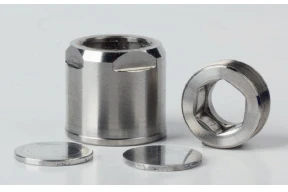
General Data:
- Volume, maximum: 0.5 ml
- Torque range: at least 0.6 Nm
Preparation of the Sample Holder:
- Coating of the aluminum disks with graphite on the outside
- Insertion of an aluminum disk in the sample holder
- Filling of the sample with powder and insertion of a second aluminum disk
- Application of a torque of at least 0.6 Nm onto the pressure screw by means of a torque
- Determination of the sample thickness by means of an outside micrometer (Attention: graphite layer!)
Measurements of the Thermal DiffusivityThermal diffusivity (a with the unit mm2/s) is a material-specific property for characterizing unsteady heat conduction. This value describes how quickly a material reacts to a change in temperature.thermal diffusivity yield the following results (figure 3 as well as the detector signal in figure 4).

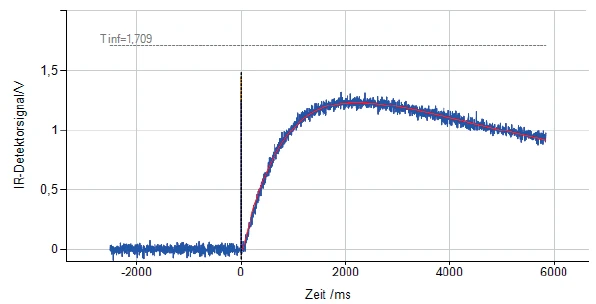
Due to missing reference materials in powder form, solid sample were additionally investigated. Vespel with low Thermal DiffusivityThermal diffusivity (a with the unit mm2/s) is a material-specific property for characterizing unsteady heat conduction. This value describes how quickly a material reacts to a change in temperature.thermal diffusivity (2.0 mm thickness) can be measured at the usual measurement time (10 half times) with ± 5% compared to the literature value (0.249 mm²/s). The influence of the measurement time on the measurement error is shown in table 1.
Sample Set-up:
- Measurements 1 to 5: standard model, only consideration of the sample without aluminum disks for investigation of the influence of the sample holder. Total thickness: 2 mm
- Measurements 6 to 8: 3-layer system, aluminum disks were considered including thickness and thermophysical properties: Total thickness: 4 mm
Measurement Results and their Assessment
Measurement 1 to 5 (table 1) show that samples with low Thermal DiffusivityThermal diffusivity (a with the unit mm2/s) is a material-specific property for characterizing unsteady heat conduction. This value describes how quickly a material reacts to a change in temperature.thermal diffusivity (Vespel) can be measured at 25°C within a tolerance of ± 5% compared to literature values (Vespel at 25°C: 0.249 mm²/s). The deviations at a measurement time of 5 half times are lower which can probably be related to external heat flows via the sample holder.
It can be assumed that powder samples up to a maximum thickness of 1 mm can be measured. For thicker samples, the signal-to-noise ratio gets worse and it is not possible to generate reliable measurement values. With regard to temperature-dependent results of the graphite powder, this tolerance is within ± 10% compared to literature value.
The very high deviations (measurements 7 to 8) are due to the influence of the thermal Contact ResistanceAccording to the second law of thermodynamics, heat transfer between two systems always moves in the direction from higher to lower temperatures. The amount of thermal energy transferred by heat conduction, e.g., through a wall of a building, is influenced by the thermal resistances of the concrete wall and the insulation layer.contact resistance. For this reason, additional measurements of the Contact ResistanceAccording to the second law of thermodynamics, heat transfer between two systems always moves in the direction from higher to lower temperatures. The amount of thermal energy transferred by heat conduction, e.g., through a wall of a building, is influenced by the thermal resistances of the concrete wall and the insulation layer.contact resistance were carried out and taken into consideration for the evaluation.
Table 1: Influence of the measurement time of a material with low thermal diffusivity
# | Measurement time | Measurement time absolut/ms | Model | Measured value/ mm²/s | Measured value/mm²/s (5 half times) | Deviation/% | Deviation/% (5 half times) |
|---|---|---|---|---|---|---|---|
| 1 | 10 half times | 23000 | Standard | 0.237 | 0.251 | -4.8 | 0.8 |
| 2 | 20 half times | 49000 | Standard | 0.235 | 0.251 | -5.6 | 0.8 |
| 3 | 30 half times | 70000 | Standard | 0.231 | 0.254 | -7.2 | 2.0 |
| 4 | 40 half times | 93000 | Standard | 0.237 | 0.243 | -4.8 | -2.4 |
| 5 | Long data acquisition | 83000 | Standard | 0.237 | 0.254 | -4.8 | 2.0 |
| 6 | 10 half times | 25000 | 3-layer | 0.161 | >20 | ||
| 7 | 10 half times | 30000 | 3-layer (graphite glue) | 0.191 | -20 | ||
| 8 | 10 half times | 30000 | 3-layer (WLP) | 0.214 | -14.1 |
Consideration of the Contact Resistance
Measurements #6 to #8 in table 1 do not consider contact resistances. Thus, the deviations in the calculated thermal diffusivities are correspondingly high. In case of #6, additional measurements of the Contact ResistanceAccording to the second law of thermodynamics, heat transfer between two systems always moves in the direction from higher to lower temperatures. The amount of thermal energy transferred by heat conduction, e.g., through a wall of a building, is influenced by the thermal resistances of the concrete wall and the insulation layer.contact resistance were carried out. By taking the Contact ResistanceAccording to the second law of thermodynamics, heat transfer between two systems always moves in the direction from higher to lower temperatures. The amount of thermal energy transferred by heat conduction, e.g., through a wall of a building, is influenced by the thermal resistances of the concrete wall and the insulation layer.contact resistance into account, the deviation is reduced to approximately 11% by using two metal disks without Thermal ConductivityThermal conductivity (λ with the unit W/(m•K)) describes the transport of energy – in the form of heat – through a body of mass as the result of a temperature gradient (see fig. 1). According to the second law of thermodynamics, heat always flows in the direction of the lower temperature.thermal conductivity paste, as demonstrated by the following calculation:

To assess the heat flow via the sample holder, measurements without a sample were carried out (figure 5). A detector signal as close as possible to the zero line is expected in order to exclude heat flows through the sample holder wall. The sharp increase at the beginning (peak) can probably be explained by the heat transfer through the air layer. Measurements under vacuum could provide information on this. Above 10000 ms, another maximum can be recognized. In the further course up to 40000 ms, a slight decrease to the 0 line can be seen. This indicates slight external heat flows through the sample holder. Taking the Vespel measurement with higher deviations above a measurement time of 1000 ms into account, the recommendation can be derived to select the layer thickness of powder samples in such a way that the measurement time (10 half times) does not exceed a value of 1000 ms. If this is not possible, the time for the calculation (set range for calculation) must be set to max. 10000 ms. Above 10000 ms, overlapping of the external heat flow mentioned is expected, shifting the signal maximum and thus the half time to higher values (= lower thermal diffusivity), is expected.
In order to consider the influence of the Contact ResistanceAccording to the second law of thermodynamics, heat transfer between two systems always moves in the direction from higher to lower temperatures. The amount of thermal energy transferred by heat conduction, e.g., through a wall of a building, is influenced by the thermal resistances of the concrete wall and the insulation layer.contact resistance, 2-layer measurements (2 metal plates upon each other) were carried out. The contact resistance determined was then used for correction of the Thermal ConductivityThermal conductivity (λ with the unit W/(m•K)) describes the transport of energy – in the form of heat – through a body of mass as the result of a temperature gradient (see fig. 1). According to the second law of thermodynamics, heat always flows in the direction of the lower temperature.thermal conductivity (addition of the thermal resistances). It must be mentioned that the following contact measurements were carried out with a changed position of the metal disks (changed air gap/contact). A measurement uncertainty of 11% was estimated for the pressure sample holder.
Figure 6 to 12 show the associated detector signals for the Vespel measurements.
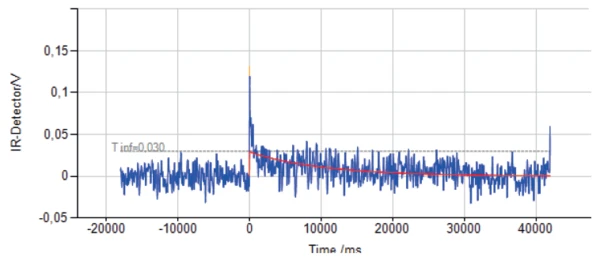


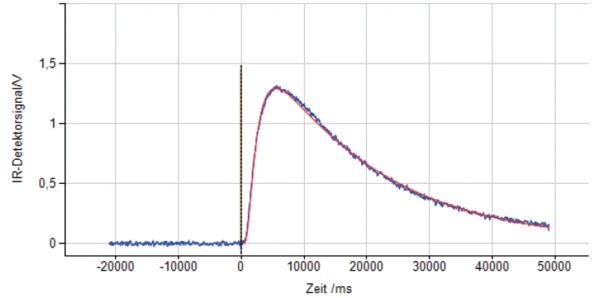
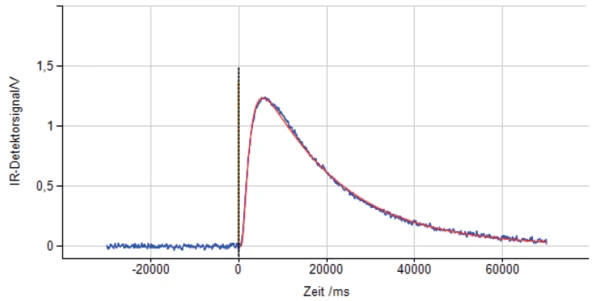

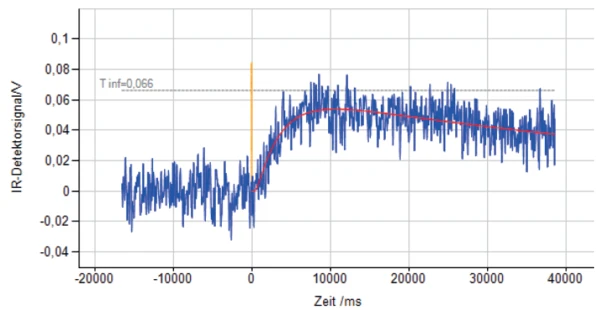

Summary
For the LFA 467 HT HyperFlash, a special sample holder for powder samples is available. This allows for measurements under mechanical pressure and requires a high degree of sample preparation. Upon careful selection of the layer thickness and application of the graphite layer, measurement uncertainties of ± 5% will be reached. Test measurements with reference samples (no powder) in the sample holder have shown that additional contact resistances between the metal plates and the sample can significantly change the result.
Order Numbers of the Sample Holder
The sample holders can be ordered under the following order numbers:
LFA 467: 6.257.1-91.9.00*
LFA 467 HT: LFA46700B96.020-00*
*Recommendation: Measurement time < 10000 ms.